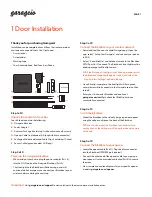
M
anual
F
ood
P
rocessing
e
quiPMent
O
peratOr
’
s
M
anual
2
S
afety
P
recautionS
To ensure safe operation, read the following statements and
understand their meaning. This manual contains safety precautions
which are explained below. Please read carefully.
WARNING
Warning is used to indicate the presence of a hazard that
can
cause
severe
personal injury, death, or substantial property damage if the
warning is ignored.
CAUTION
Caution is used to indicate the presence of a hazard that
will
or
can
cause
minor
personal injury or property damage if the caution is
ignored.
NOTE
Note is used to notify people of installation, operation, or
maintenance information that is important but not hazard-related.
For Your Safety!
These precautions should be followed at all times. Failure to follow
these precautions could result in injury to yourself and others or
damage the equipment.
To reduce risk of injury or damage to the unit:
Check machine before each use to insure the equipment is clean.
Check for broken, nicked or dull blades and if found, replace blade.
f
unction
and
P
urPoSe
Easily pierce and safely open cans.
B
aSe
i
nStallation
Installing the can opener base:
1. Choose a convenient location with a firm work surface (C) and install the
base (A) securing with the hardware (B) provided. See Figure 1.
On thin gauge work surface we suggest you fit a spacer plate
underneath. This will prevent the flexing of the work surface and possible
spillage of can contents during opening.
C
B
A
B
B
Figure 1. Base to Work Surface Installation.
o
Peration
Prior to first use, it is important to clean the unit. Wash the unit with warm
soapy water and rinse thoroughly to remove the thin protective oil film.
2. Place the can opener bar (A) into the base (B) as shown in Figure 2.
A
B
Figure 2. Bar into Base Installation.
WARNING
Sharp Blade Hazard.
Blades are sharp and can cause cuts.
To avoid injury from sharp blades, handle with caution. Only trained
personal should operate equipment or perform maintenance.
3. Move the handle (A) to the UP position as shown. Place the can (B)
against the bar (C). Using a swift downwards movement, punch the
blade (D) into the can lid. See Figure 3.
C
B
A
D
Figure 3. Punching the Blade into the Can.


























